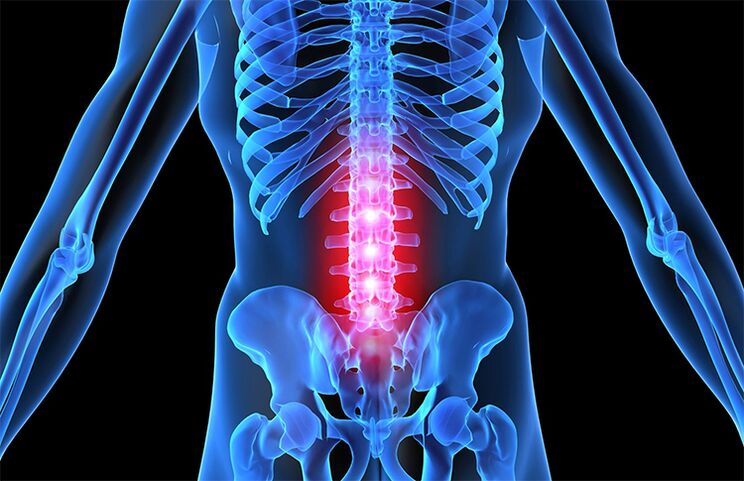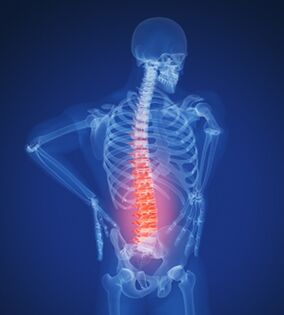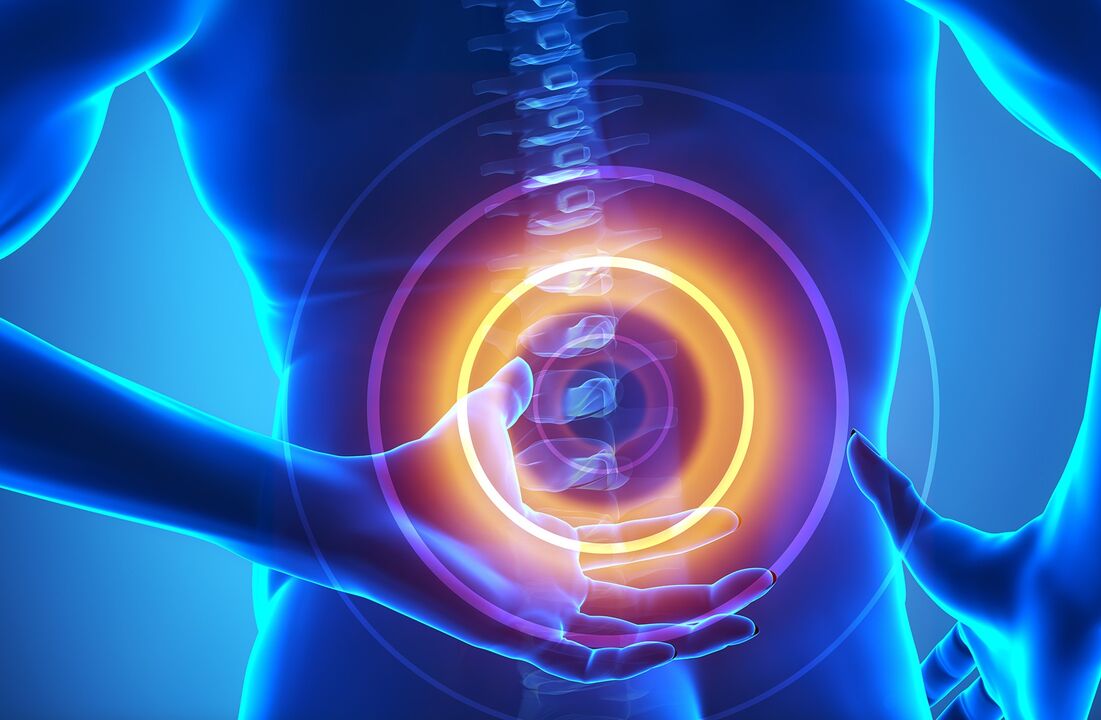
Many people experience lower back pain at least once three decades later. By age 60, 80% of people will experience this discomfort. Almost always, the cause is osteochondrosis of the lumbar spine. This pathology causes the development of unpleasant symptoms and can greatly impair the quality of human life. In order to prevent the development of negative consequences, it is very important to consult a doctor promptly.
Clinical features of lumbar osteochondrosis
This disorder is common because the lower back is most often subjected to high loads. The lumbar region contains five vertebrae, in addition, it connects the sacral and thoracic regions. The intervertebral disc, which consists of the nucleus pulposus, provides it with flexibility. These elements are located within the annulus fibrosus.
Osteochondrosis can cause nutritional deficiencies in the intervertebral discs. Because of this, they become less resilient. In addition, their height has been reduced. Reducing the distance between the vertebrae can cause invasion of the nerve roots. As a result, tangible pain occurs in the lower back.
In the initial stages, symptoms of osteochondrosis are mild and may even be absent at all. However, further progression of the disease can cause back and leg pain, and numbness may occur.
After the change has spread, the likelihood of immobilizing the spine is reduced. Hernias and subluxations sometimes occur - these conditions are associated with pain. Subsequently, disc rupture and compression of nerve endings may even occur.
As the disease progresses, blood vessels, ligaments, and the spinal cord become involved in the process. Bone growth may occur. In the final stage, paralysis and paresis appear. Sometimes the function of the pelvic organs is disturbed.
In young people, the disease progresses. In old age, the pathology may not manifest in any way despite the changes. If treatment for the disease is not started promptly, it can have very dangerous consequences.
degree
The pathology is irreversible and its symptoms are directly determined by the degree:
- first level. During this period, the nucleus pulposus undergoes pathological processes. There is discomfort associated with nerve ending stimulation. They may be sharp or painful in nature. If spasm of the large arteries of the thigh occurs, the blood circulation is disturbed, which is full of the appearance of arterial lesions in the legs.
- second degree. The destruction of the annulus fibrosus continues. Due to the loss of stability, the vertebrae become too flexible. As a result, muscle tissue becomes overly tense. The patient's lumbar muscles were highly fatigued and uncomfortable.
- Three degrees. The annulus fibrosus ruptures, resulting in the release of the nucleus pulposus contents. This process can cause a hernia to form. Have nerve root syndrome. Initially, the patient feels hypersensitive, burning, tingling, and numbness in the affected area. Sometimes the sensitivity may disappear completely. In severe cases, paralysis and muscle wasting can occur.
- Level four. The work of the vertebrae, the structures of the joints and ligaments is destroyed. The development of joint arthropathy. The pain may disappear, and the support function of the spine is restored, but the magnitude is significantly reduced. Fourth degree is characterized by multiple symptoms of the disease.
reason

More than a third of people with this type of osteochondrosis have problems with the liver or digestive organs. In the presence of this deviation, there is tension and spasm of muscles and blood vessels, which can lead to the appearance of hypoxia and malnutrition abnormalities. These processes are exacerbated by metabolic disturbances.
The appearance of this form of osteochondrosis is usually the result of congestion of the pelvic organs. They may be associated with constipation, colitis, hemorrhoids. In women, these problems are the result of inflammation of the appendages, and in men prostatitis.
Other causes of osteochondrosis include:
- Lack of physical activity.
- joint disease.
- Digestive problems.
- Back injury.
- Pathology of the heart and blood vessels.
- endocrine system diseases.
- Spinal problems.
- inflammation.
- flatfoot.
- Increase physical activity.
- Metabolic disorders.
- age changes.
There are also risk factors that greatly increase the likelihood of developing lumbar osteochondrosis:
- overweight;
- hereditary;
- Improper nutrition;
- violate posture;
- prolonged periods of time in uncomfortable positions;
- chronic sleep deprivation;
- frequent stress;
- low temperature.
symptoms and signs
The disease manifests in the form of pain syndromes and can have different features. Osteochondrosis is characterized by pulling, pain, and cutting sensations. Not only discomfort in the legs, but also discomfort in the tailbone or lower chest.
Photos show pain syndrome in lumbar osteochondrosis

In addition to pain, there are violations like this:
- muscle tension;
- reproductive system problems;
- Violation of a woman's menstrual cycle;
- constipate;
- postural changes;
- asymmetrical hips;
- loss of sensitivity;
- fatigue;
- tingling and cold in the legs;
- loss of activity;
- Insomnia;
- unstable emotion.
Worsening of osteochondrosis is usually the result of careless exercise or high load. In addition, recurrence of the disease often occurs due to hypothermia. Severe pains can be felt not only in the lower back - they often affect the lower extremities. During exacerbations, a person tries to find a comfortable position to achieve pain relief.
Symptoms of lumbosacral osteochondrosis
This form of the disease is also characterized by back pain. They can be felt in the lower back or in the legs near the sciatic nerve. The manifestations of the disease do not occur immediately, but approximately in the second stage of the development of the disease.
At first, they are felt during careless movements or loads. But over time, the pain persists and has the characteristics of pain. When discomfort becomes more pronounced, it sometimes gets worse. In advanced cases, pain occurs with sneezing, coughing, and light exercise.
When nerve endings are pinched, radiculopathy syndrome occurs and is characterized by:
- behind-the-scenes shooting;
- loss of sensation in the extremities;
- tingling in the legs;
- Decreased tendon reflexes;
- Violation of sweating;
- cold legs;
- Muscle weakness.
As the disease progresses, the back loses elasticity, and any changes in body position or load can cause severe pain. As a result, mobility is limited, a person has difficulty bending, and muscle spasms.
Effect
Neglecting the symptoms of osteochondrosis will sooner or later lead to negative consequences of the disease. As the distance between the vertebrae decreases, blood vessels are squeezed, which causes problems with the nutrition of the spinal cord.
As a result, pain, muscle weakness, and loss of reflexes occur. Enuresis, fecal incontinence, and lower extremity paralysis may occur.
Another dangerous complication is a hernia. It can also cause severe pain and spinal cord compression. As a result, the legs may become desensitized and the reflexes disappear. Sometimes the work of the reproductive and urinary system organs is disturbed. Digestive problems can also occur.
This form of osteochondrosis can cause instability in the spine. Under the influence of gravity, the lower back appears to slide off the sacrum. For women, the condition is fraught with problems with the internal organs - ovaries, uterus, appendages. Men may experience impotence due to this disorder.
Osteochondrosis of the lumbar spine often causes problems with blood circulation to the spinal cord. Another consequence is compressive myelopathy. As the spinal canal narrows, spinal cord problems arise.
However, the most complicated condition is "ponytail" syndrome, which is thought to be the result of damage to the nerve roots. In severe cases, it can cause quadriplegia and paralysis.
diagnosis method
To diagnose osteochondrosis, doctors review a patient's medical history and perform a visual examination. Common urine and blood tests are also done. With their help, other serious diseases can be ruled out.
An important criterion is to assess the condition of the legs. It is important to determine the condition of the skin, blood vessels, and muscle tone. Women were also referred to gynecologists. Men need to be examined by a urologist.
The following types of diagnostics are required:
- radiography;
- CT scan;
- Magnetic resonance imaging.
how to treat
For the treatment of the disease, medical, physical therapy and surgical techniques can be used. The main goal is to eliminate the manifestations of the disease and prevent its development.
Medications use anti-inflammatory and analgesic drugs. Be sure to take B vitamins. To cope with mental illness, sedatives and anticonvulsants are used. During exacerbations, neocaine blockers may be used.
Of the non-drug therapies, therapeutic exercise, acupuncture, and massage are the most effective. You can also perform electrophoresis and ultrasound electrophoresis. If the conservative method gives no result, then perform the action.
Osteochondrosis of the lumbar spine is considered a rather dangerous pathology that can lead to extremely negative health consequences. To prevent this from happening, be sure to consult your doctor if you experience any back discomfort.


















